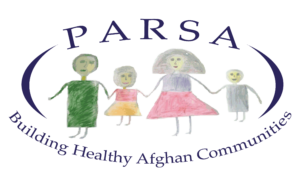These photographs were shared by PARSA supporters of their time in Afghanistan before the Soviet invasion of 1979. If you would like to share your photographs for our collection, please contact alyssa@afghanistan-parsa.org.
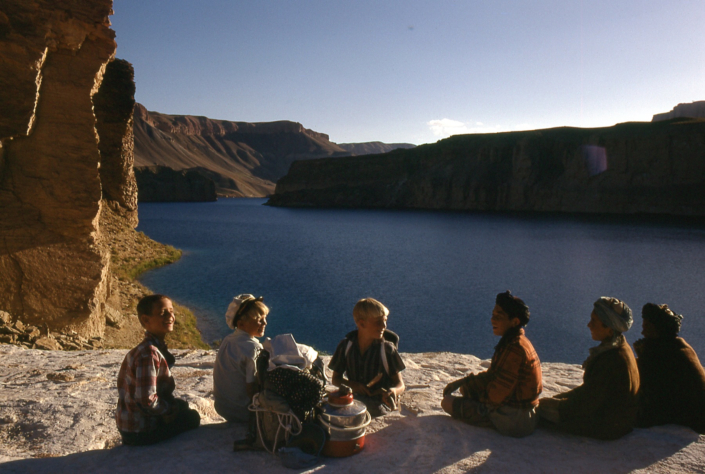
Friberg & Afghan boys at Band-e-Amir. Picture taken by Norman L. Friberg c. 1957-1971, submitted by his son, Wes Friberg.
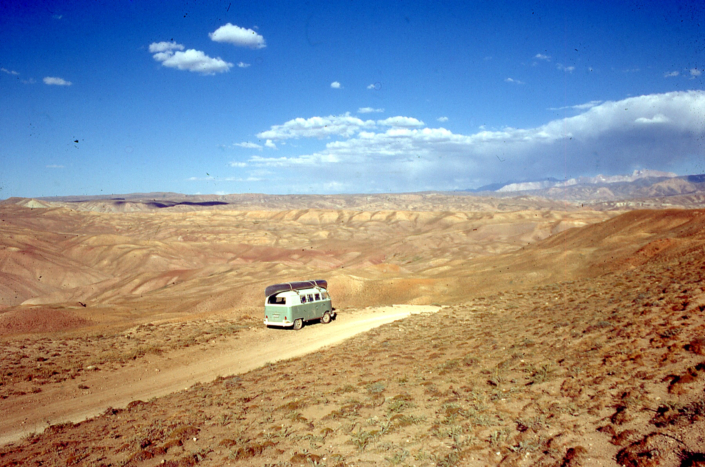
Friberg's VW van & canoe in the Hazarjat. Picture taken by Norman L. Friberg c. 1957-1971, submitted by his son, Wes Friberg.
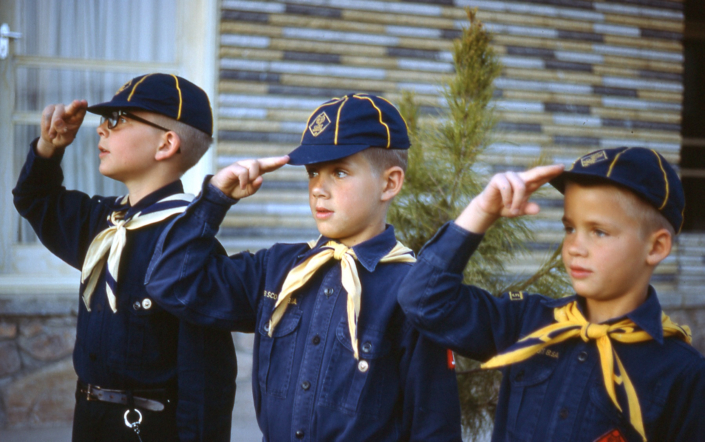
Friberg Cub Scouts in Kabul. Picture taken by Norman L. Friberg c. 1957-1971, submitted by his son, Wes Friberg.
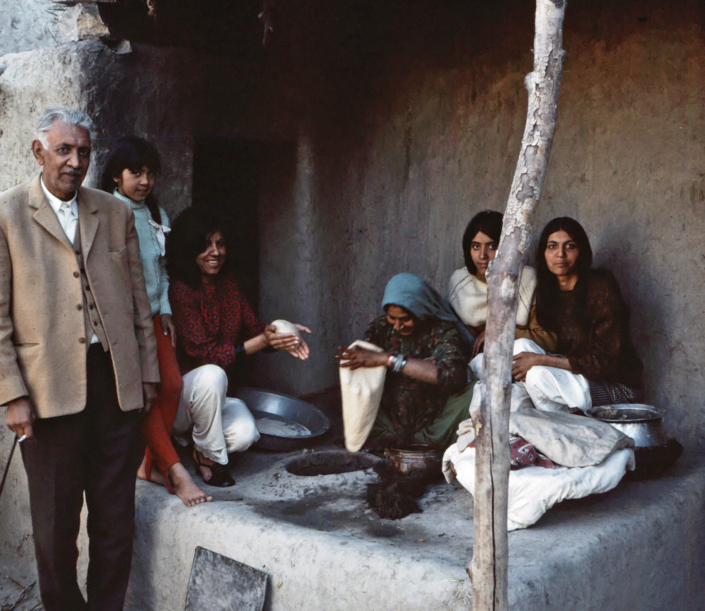
Sent by Brad Child: Kabul/Jalalabad c 1969

Sent by Brad Child: Kabul/Jalalabad c 1969
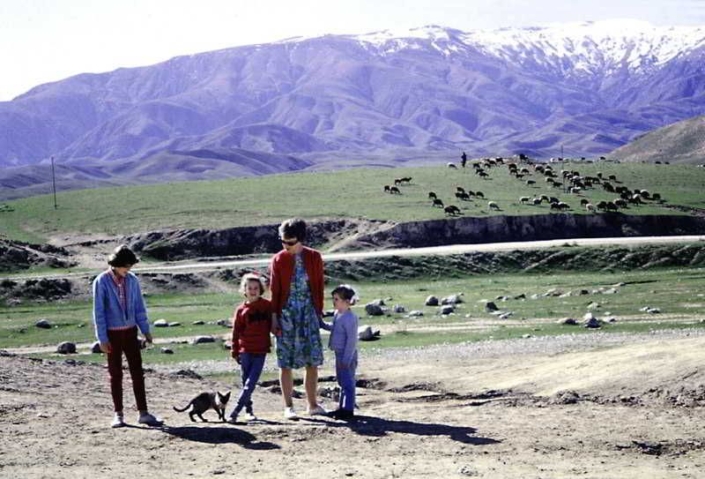
From the family album of Marnie Gustavson.
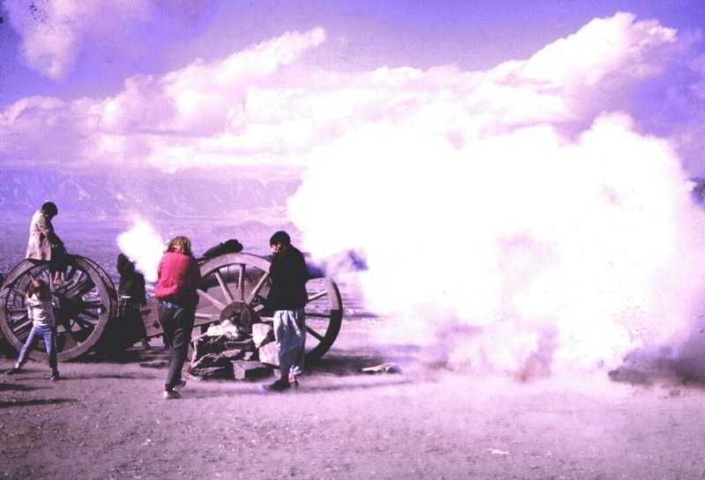
From the family album of Marnie Gustavson.
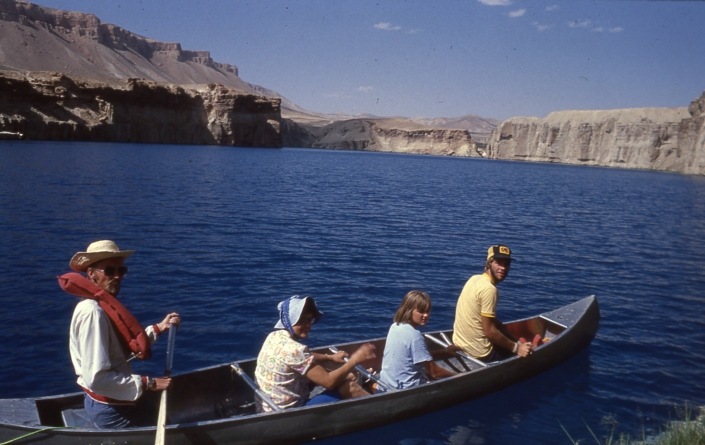
Friberg family (& friend in stern) canoeing on Band-e-Amir Lake. Picture taken by Norman L. Friberg c. 1957-1971, submitted by his son, Wes Friberg.
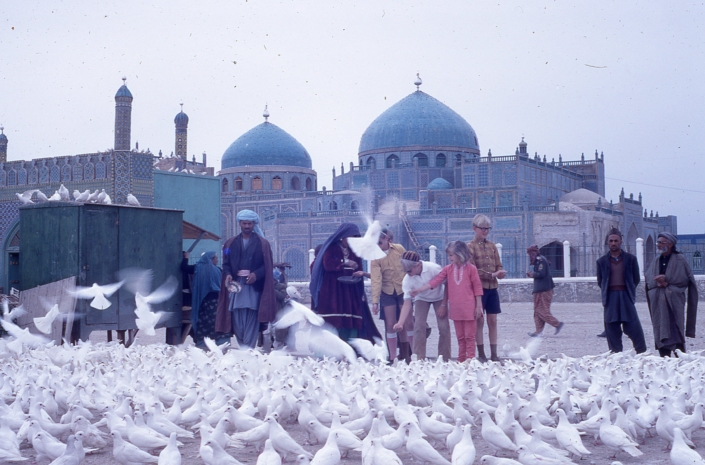
Mazar-i-Sharif. Wes Friberg and his family lived in Afghanistan from 1957-1971

Fran Hartung, age 4, 1966 on a buzkhashi horse with a horseman in Doshi.

Kabul. Wes Friberg and his family lived in Afghanistan from 1957-1971
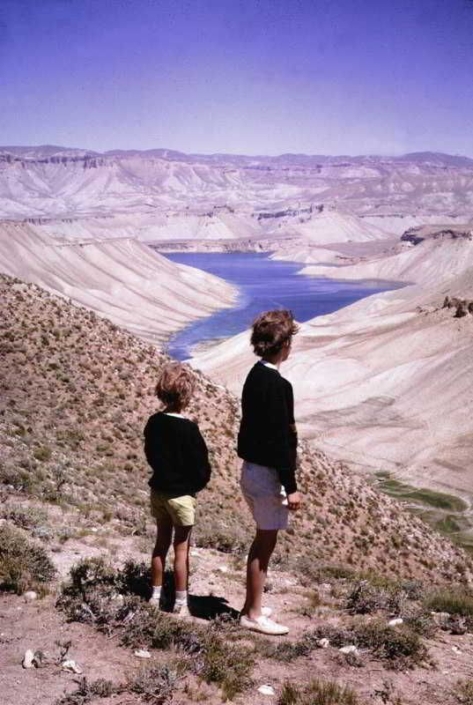
From the family album of Marnie Gustavson.
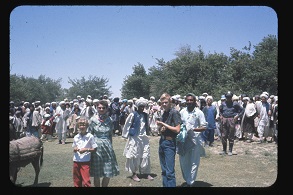
JoAnn Dewhurst Koozer and family on a picnic in Malgir in 1961.
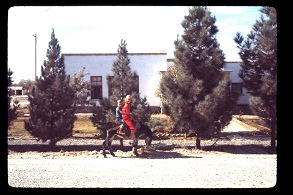
JoAnn Dewhurst Koozer and Mark Mir on a donkey outside their house in 1961.

Norm Friberg & 3 kids on a cow skin raft on the Kabul River near Jalalabad. Picture taken by Norman L. Friberg c. 1957-1971, submitted by his son, Wes Friberg.

From the family album of Marnie Gustavson.
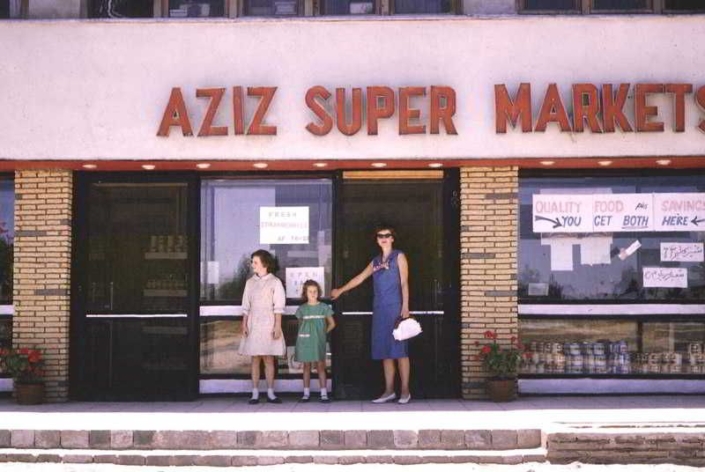
From the family album of Marnie Gustavson.

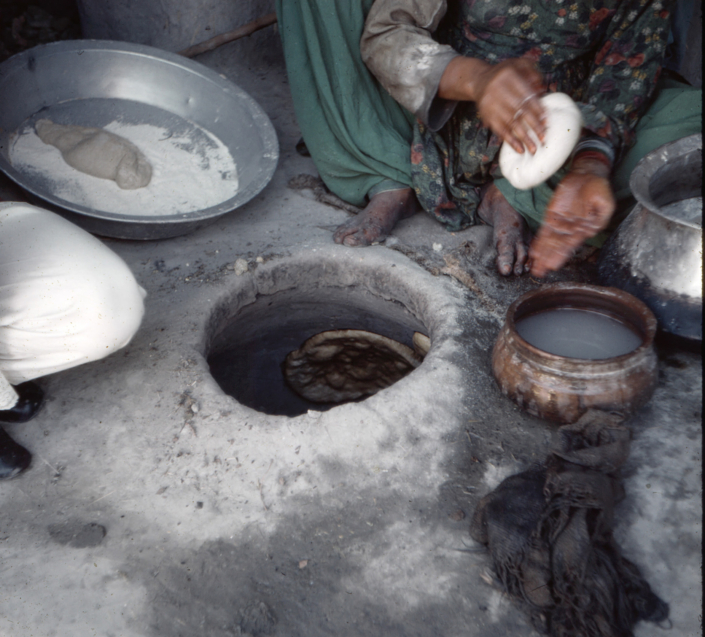
Sent by Brad Child: Kabul/Jalalabad c 1969

From the family album of Marnie Gustavson.
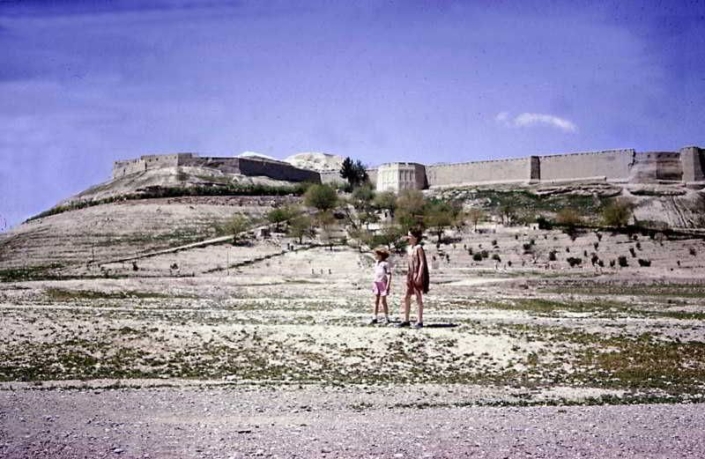
From the family album of Marnie Gustavson.
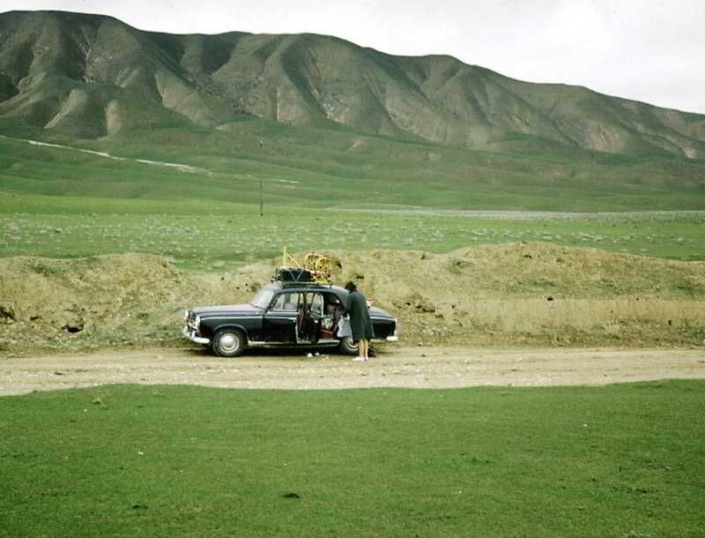
On a day trip. From the family album of Marnie Gustavson.
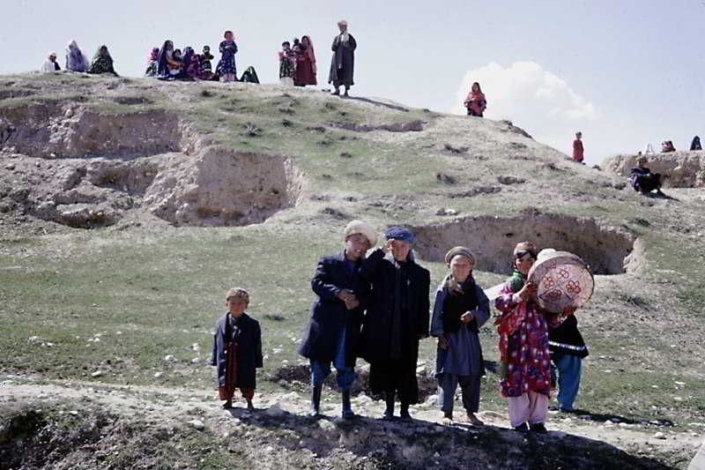
From the family album of Marnie Gustavson.
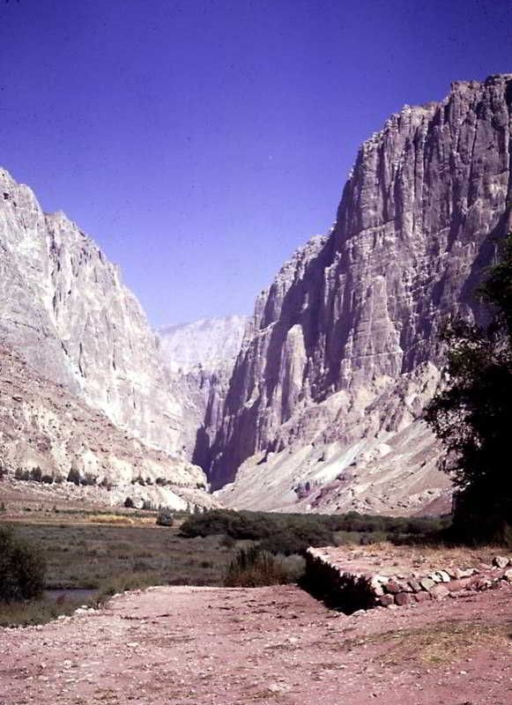
From the family album of Marnie Gustavson.
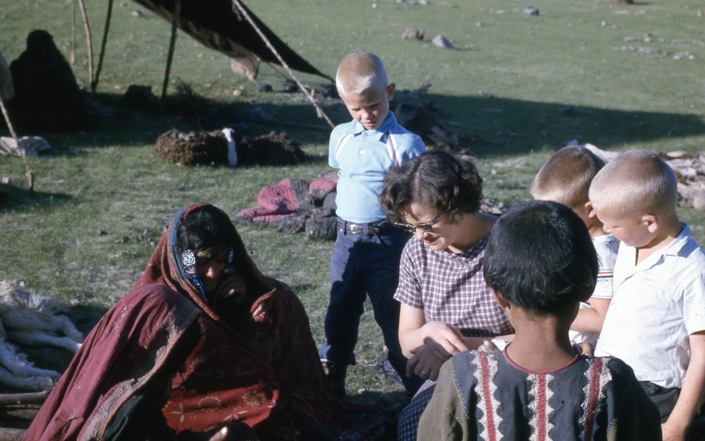
Friberg family visiting Kuchis. Picture taken by Norman L. Friberg c. 1957-1971, submitted by his son, Wes Friberg.
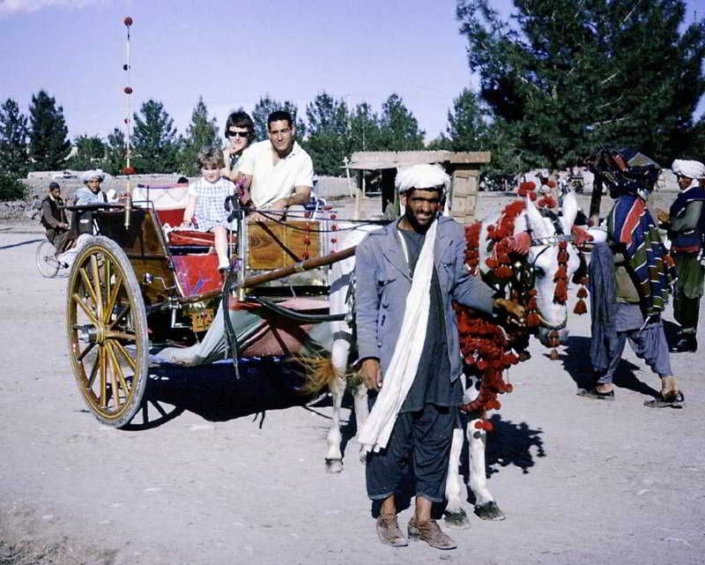
From the family album of Marnie Gustavson.
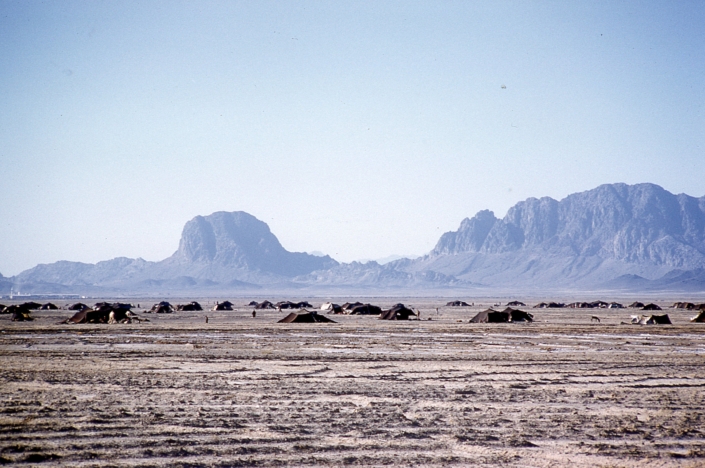
Kuchi camp outside Kandahar--with "Elephant" Mountain in background. Picture taken by Norman L. Friberg c. 1957-1971, submitted by his son, Wes Friberg.
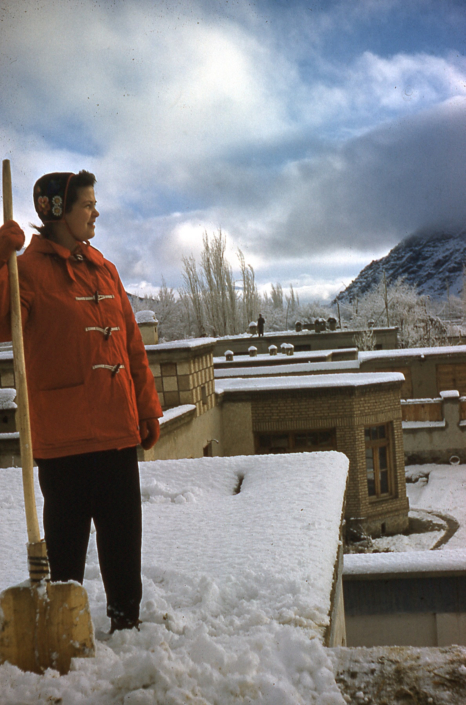
Jacque Friberg shoveling snow off the roof of our Kart-e-Char house. Picture taken by Norman L. Friberg c. 1957-1971, submitted by his son, Wes Friberg.
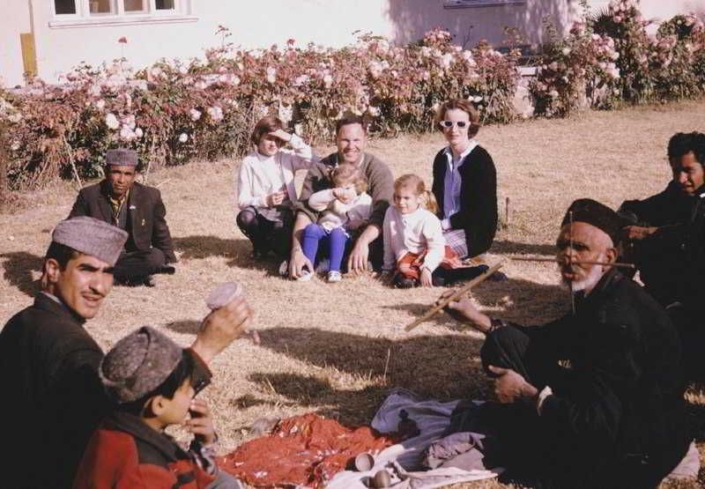
From the family album of Marnie Gustavson.
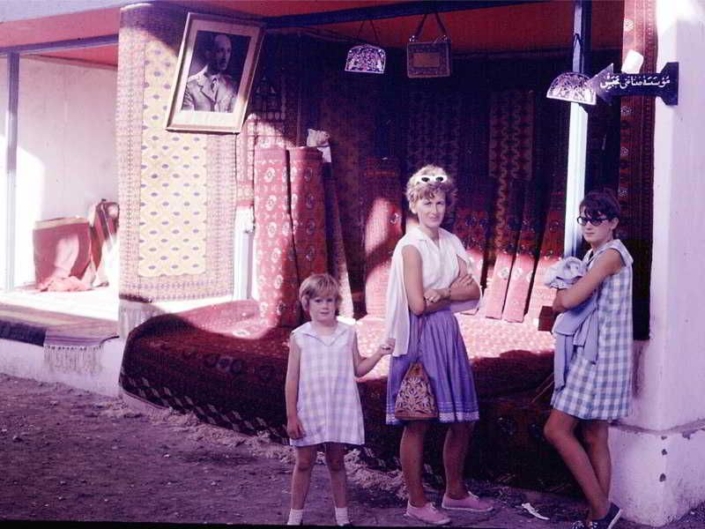
From the family album of Marnie Gustavson.
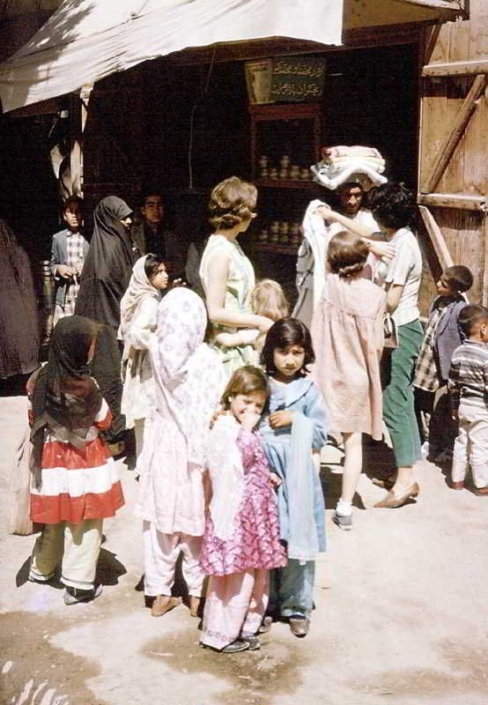
From the family album of Marnie Gustavson.
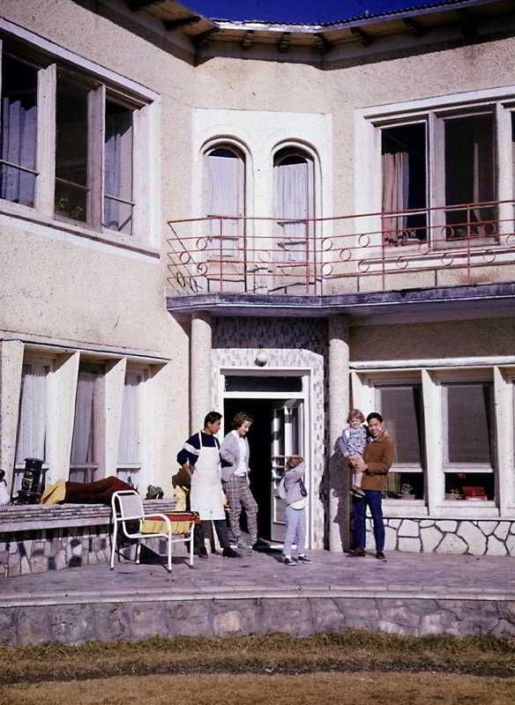
From the family album of Marnie Gustavson.
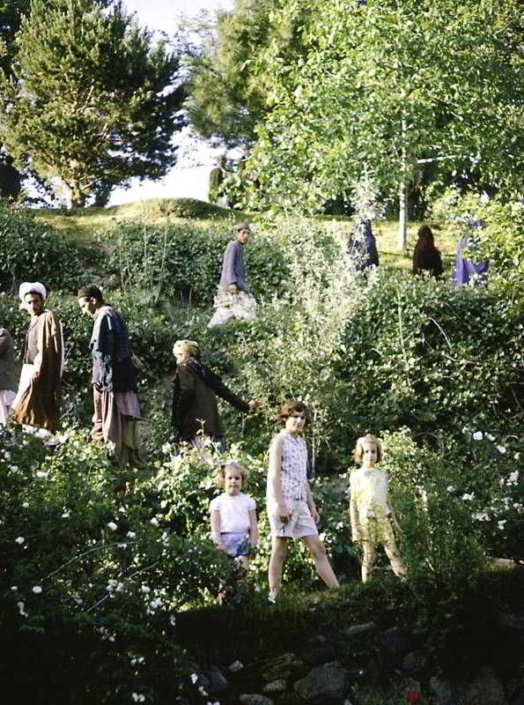
From the family album of Marnie Gustavson.

From the family album of Marnie Gustavson.
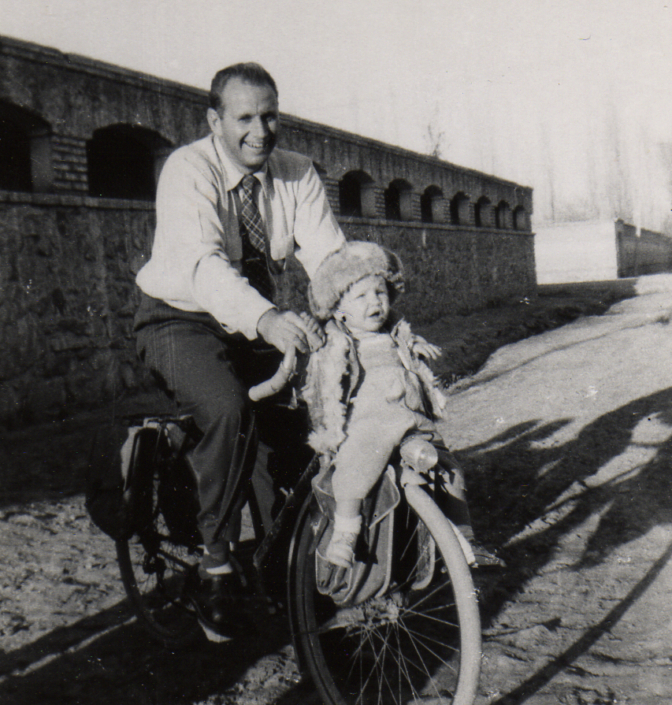
Norm Friberg giving son, Wes, a bike ride in Kabul. Picture taken by Norman L. Friberg c. 1957-1971, submitted by his son, Wes Friberg.
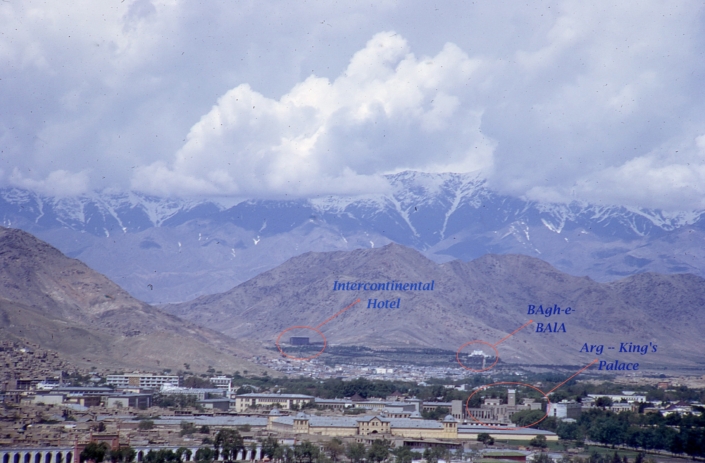
View of the Shahr-e-Naw area of Kabul. Picture taken by Norman L. Friberg c. 1957-1971, submitted by his son, Wes Friberg.
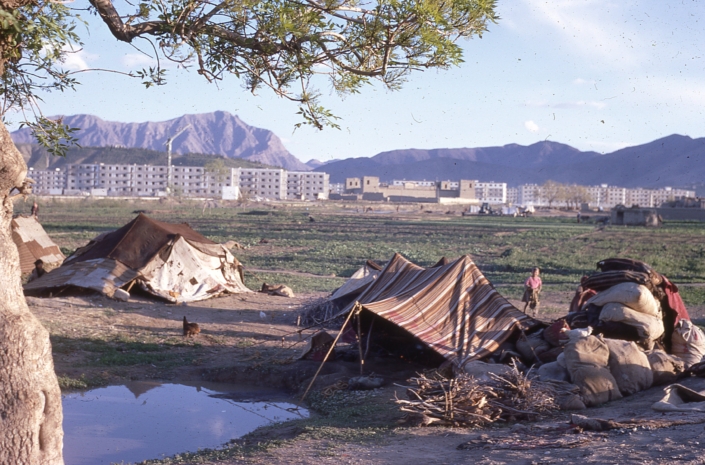
View of the Microrayan area of Kabul, towards the airport. Picture taken by Norman L. Friberg c. 1957-1971, submitted by his son, Wes Friberg.
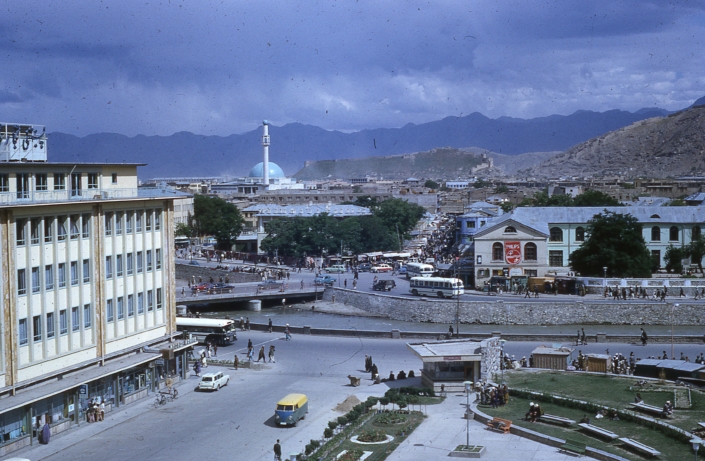
View from the Spinzar Hotel towards the Kabul River & the Bala Hissar. Picture taken by Norman L. Friberg c. 1957-1971, submitted by his son, Wes Friberg.
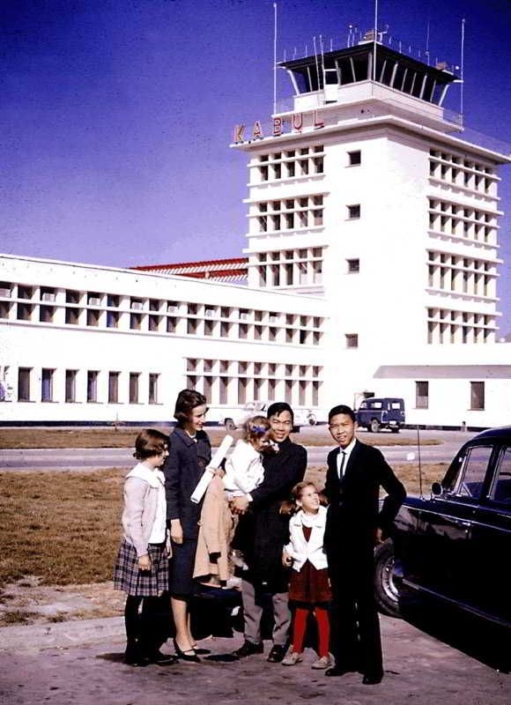
From the family album of Marnie Gustavson.
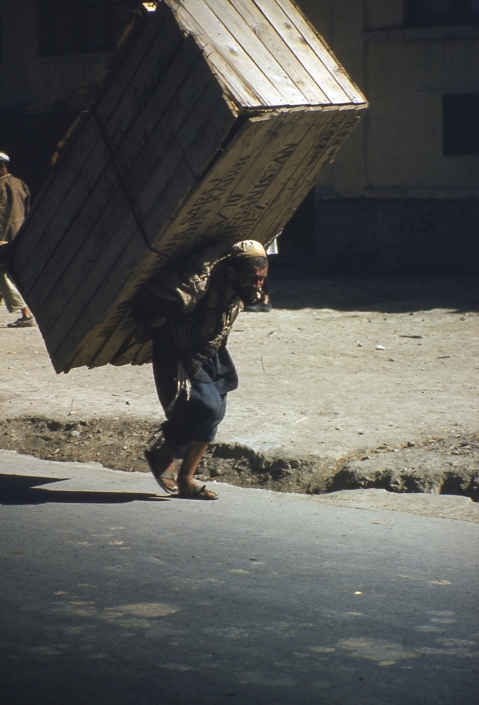
Day laborer. Picture taken by Norman L. Friberg c. 1957-1971, submitted by his son, Wes Friberg.

Barbershop. Picture taken by Norman L. Friberg c. 1957-1971, submitted by his son, Wes Friberg.
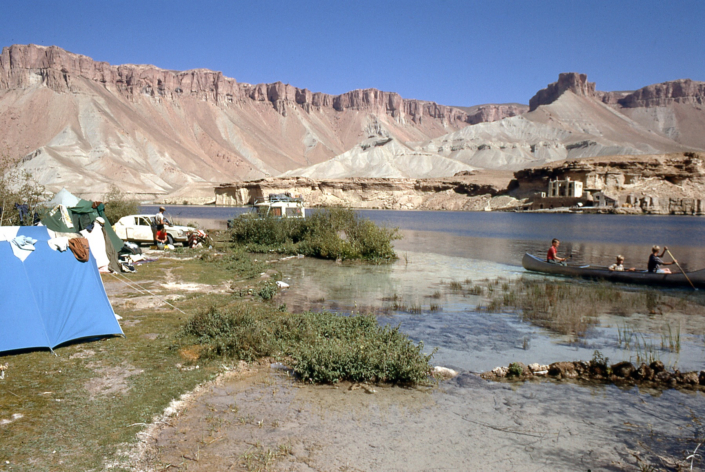
Campsite at Band-e-Amir. Picture taken by Norman L. Friberg c. 1957-1971, submitted by his son, Wes Friberg.
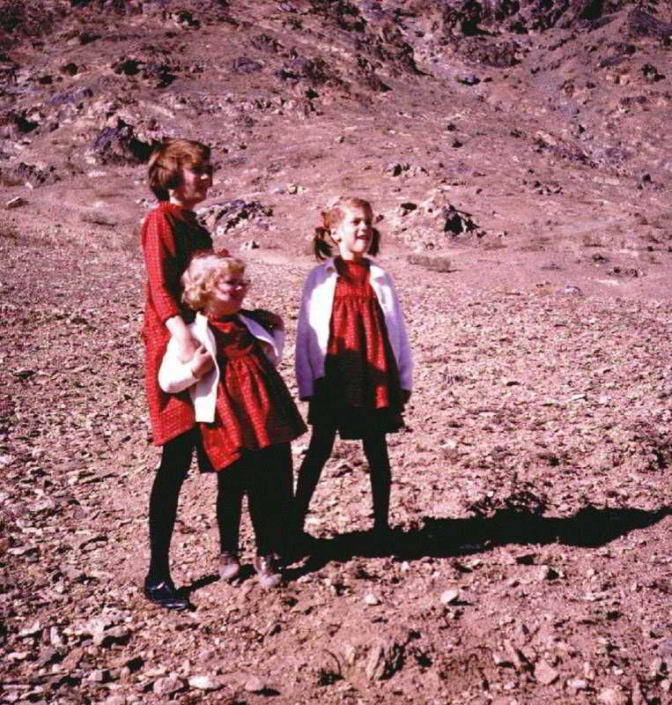
From the family album of Marnie Gustavson.
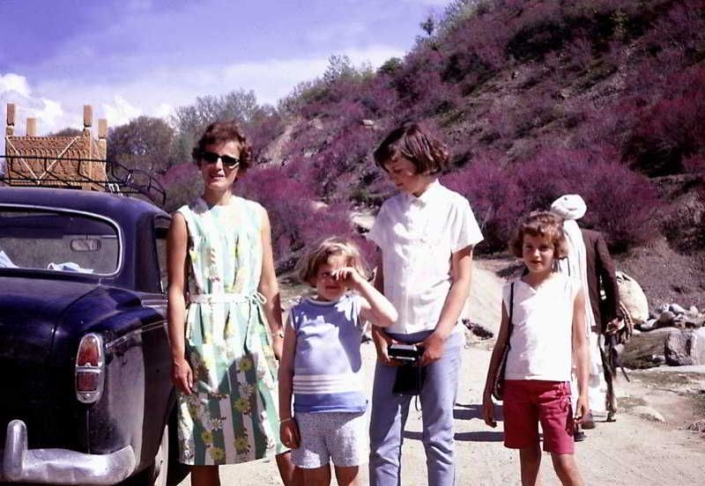
From the family album of Marnie Gustavson.
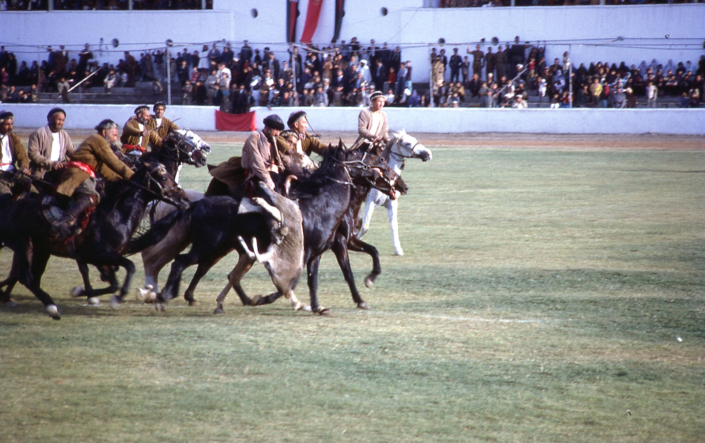
Buzkashi game in Kabul Stadium for King's Birthday. Picture taken by Norman L. Friberg c. 1957-1971, submitted by his son, Wes Friberg.
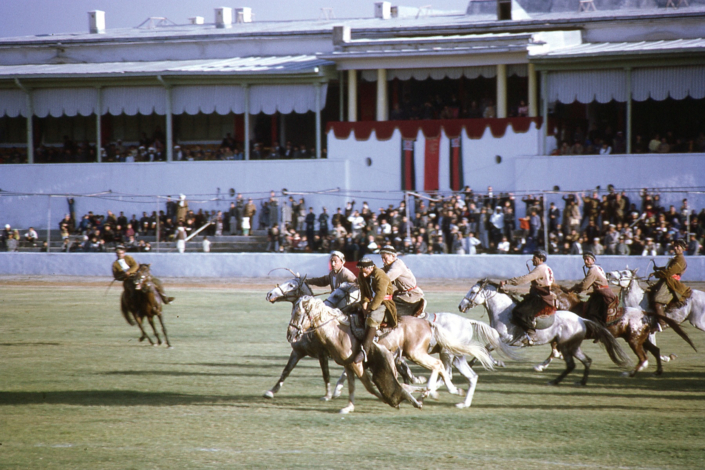
Buzkashi game in Kabul Stadium for King's Birthday. Picture taken by Norman L. Friberg c. 1957-1971, submitted by his son, Wes Friberg.
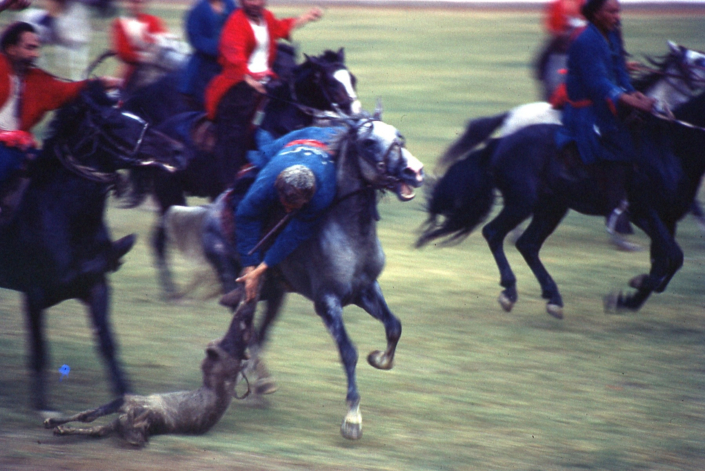
Buzkashi game in Kabul Stadium for King's Birthday. Picture taken by Norman L. Friberg c. 1957-1971, submitted by his son, Wes Friberg.
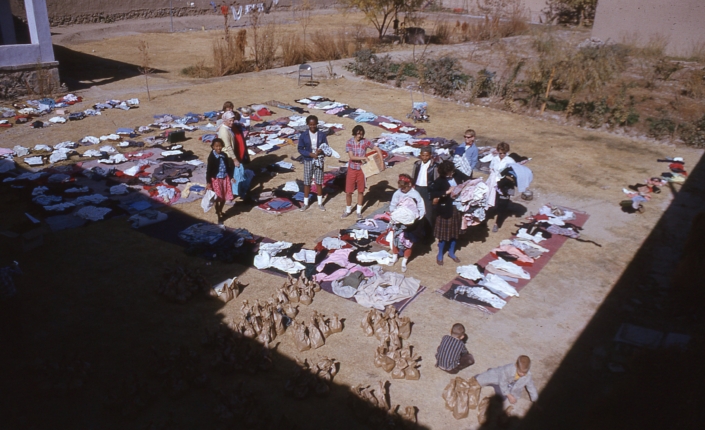
Gathering clothes/gifts for Maristoon in Kandahar (in our backyard). Picture taken by Norman L. Friberg c. 1957-1971, submitted by his son, Wes Friberg.
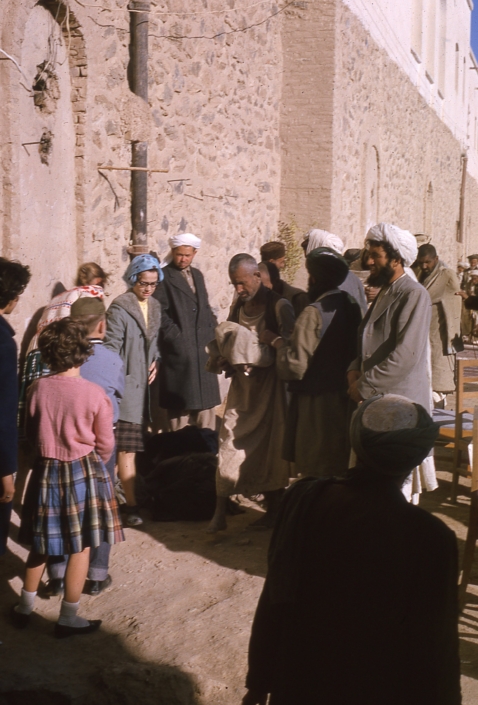
Delivering clothes/gifts to Maristoon in Kandahar. Picture taken by Norman L. Friberg c. 1957-1971, submitted by his son, Wes Friberg.
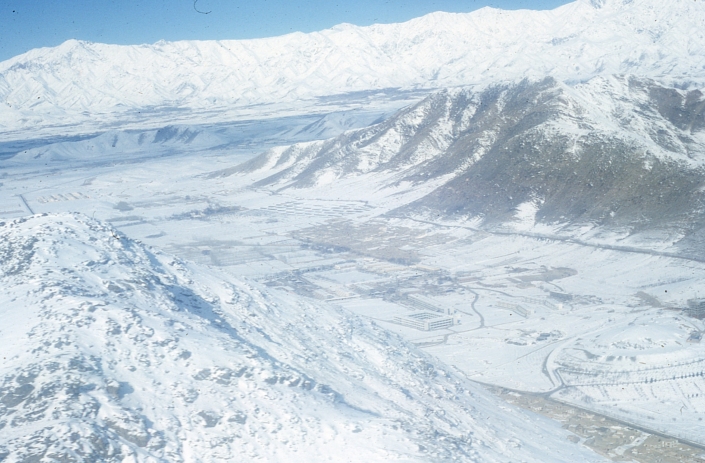
Aerial view of Afshar area of Kabul--Intercontinental Hotel under construction on right side (Maristoon in background?) Picture taken by Norman L. Friberg c. 1957-1971, submitted by his son, Wes Friberg.
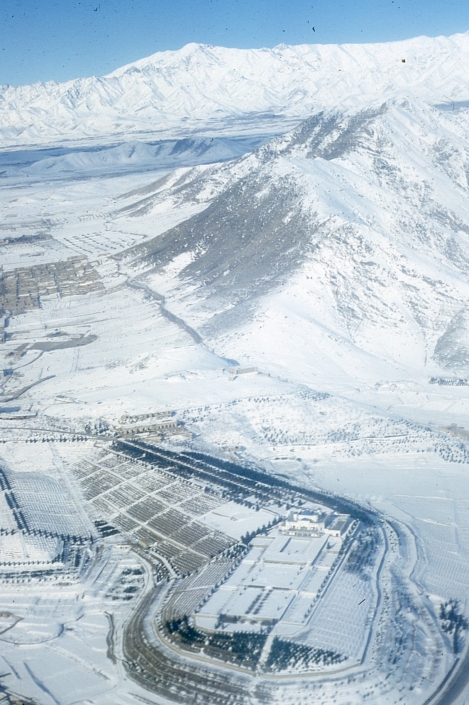
Aerial view of Bagh-e-Bala area of Kabul (Maristoon in background?) Picture taken by Norman L. Friberg c. 1957-1971, submitted by his son, Wes Friberg.
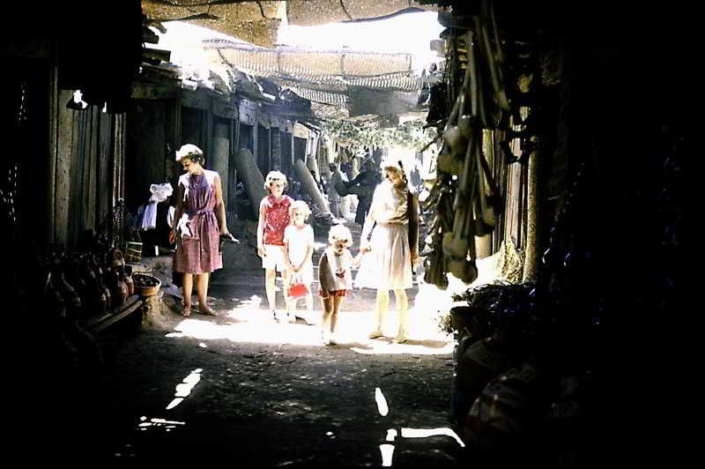
From the family album of Marnie Gustavson.
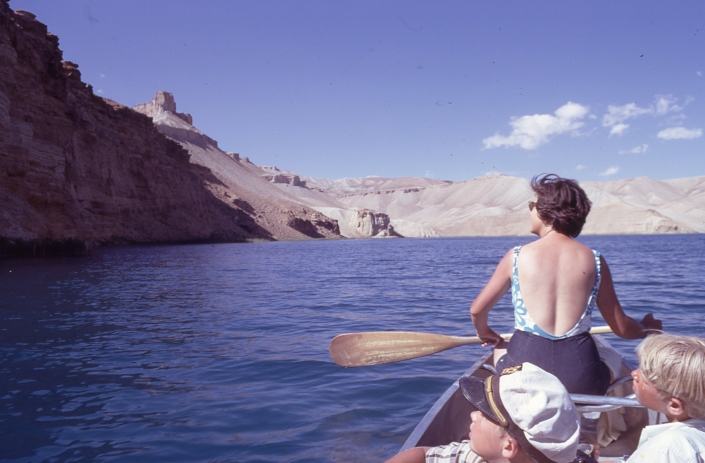
Friberg family canoeing on Band-e-Amir Lake. Picture taken by Norman L. Friberg c. 1957-1971, submitted by his son, Wes Friberg.
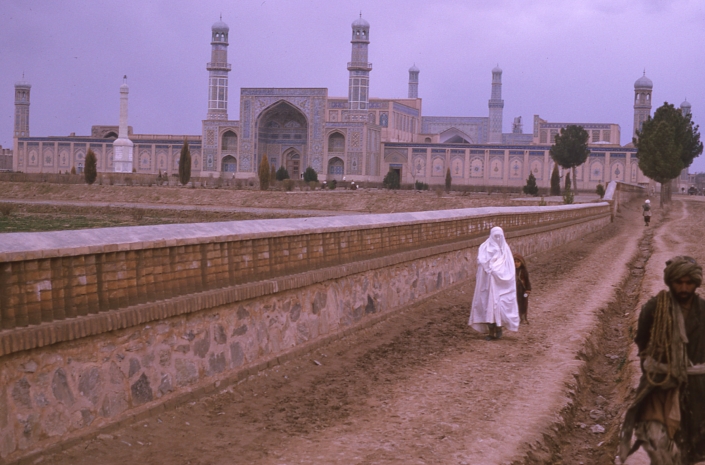
The Blue Mosque in Herat. Picture taken by Norman L. Friberg c. 1957-1971, submitted by his son, Wes Friberg.
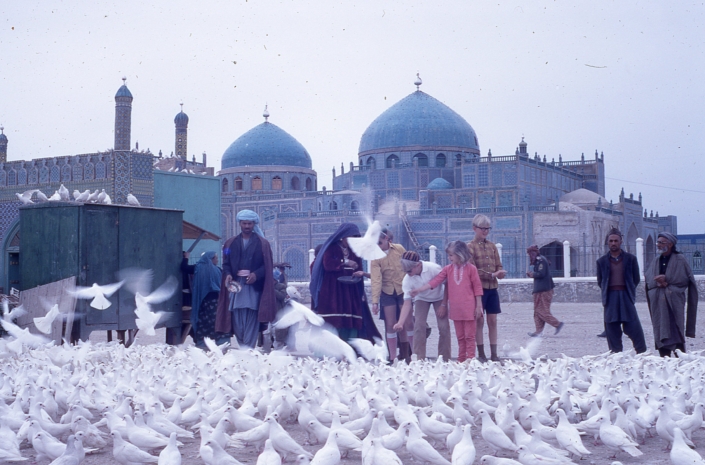
Friberg kids at the Rowza in Mazar-i-Sharif. Picture taken by Norman L. Friberg c. 1957-1971, submitted by his son, Wes Friberg.
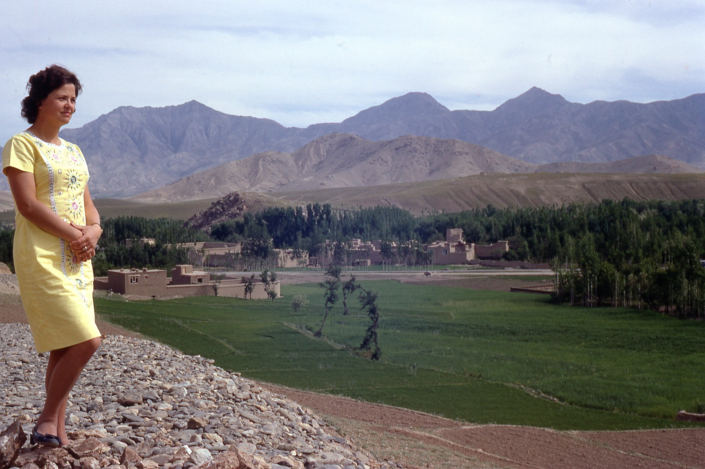
Jacque Friberg (maybe in Shomali, just north of Kabul?) Friberg family visiting Kuchis. Jacque Friberg (maybe in Shomali, just north of Kabul?) Picture taken by Norman L. Friberg c. 1957-1971, submitted by his son, Wes Friberg.
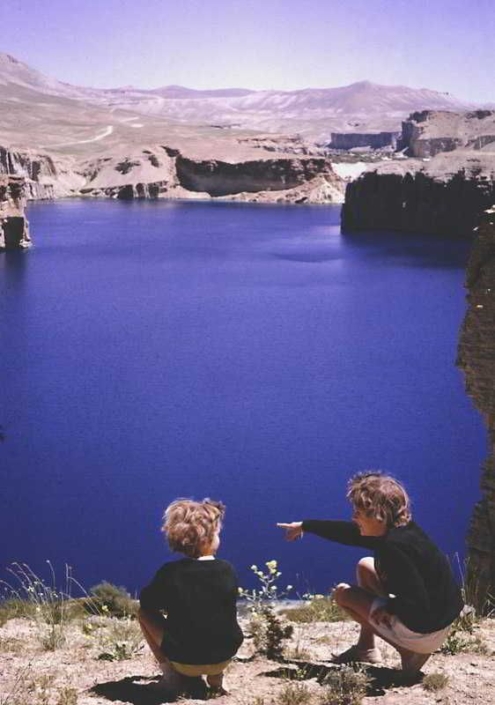
From the family album of Marnie Gustavson.
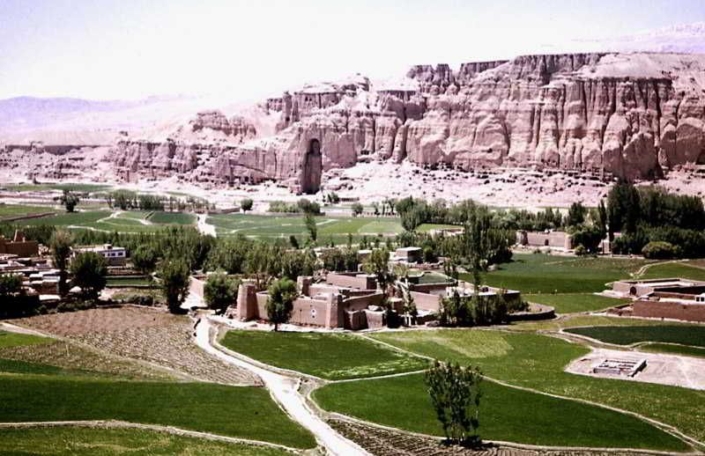
From the family album of Marnie Gustavson.

Jacque Friberg at Band-e-Amir lakes. Picture taken by Norman L. Friberg c. 1957-1971, submitted by his son, Wes Friberg.
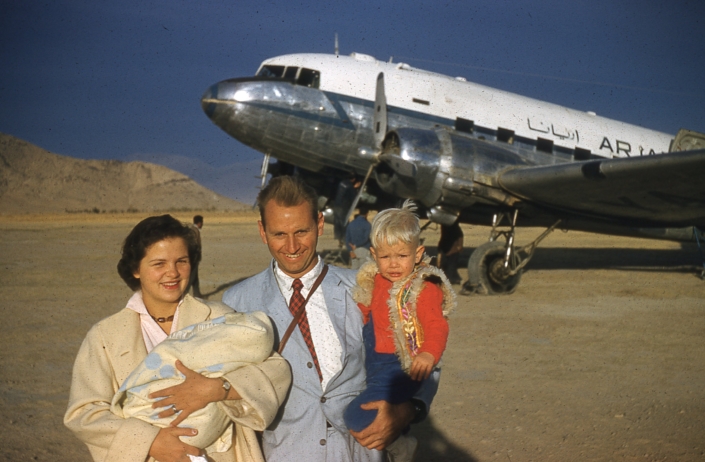
Norm & Jacque Friberg and two younguns (Wes & Torrey) traveling on an Ariana DC-3. Picture taken by Norman L. Friberg c. 1957-1971, submitted by his son, Wes Friberg.
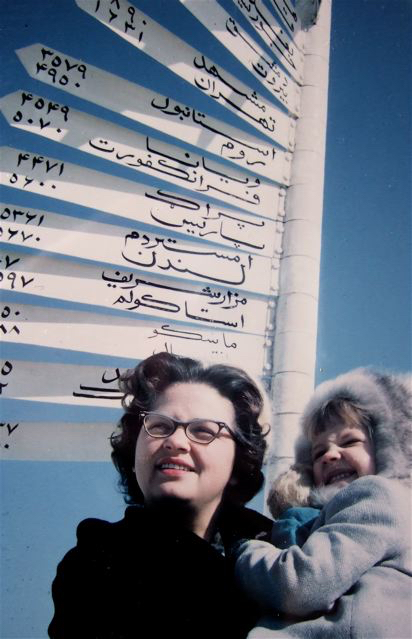
Jacque Friberg and daughter Cathi by Afghan signpost. Picture taken by Norman L. Friberg c. 1957-1971, submitted by his son, Wes Friberg.
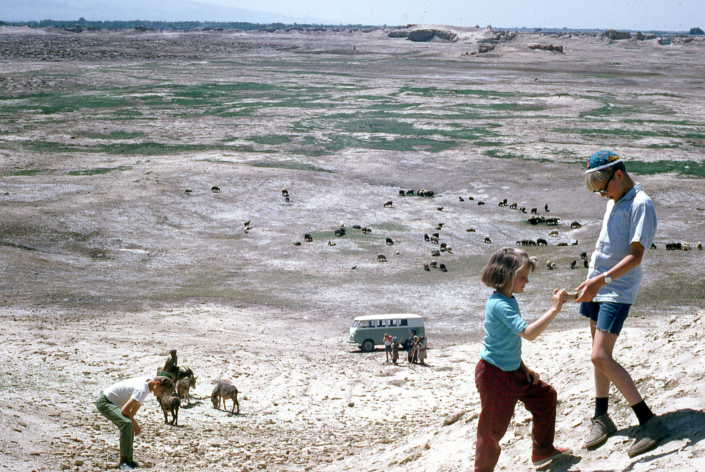
Friberg family doing some exploring around the old Kandahar City. Picture taken by Norman L. Friberg c. 1957-1971, submitted by his son, Wes Friberg.
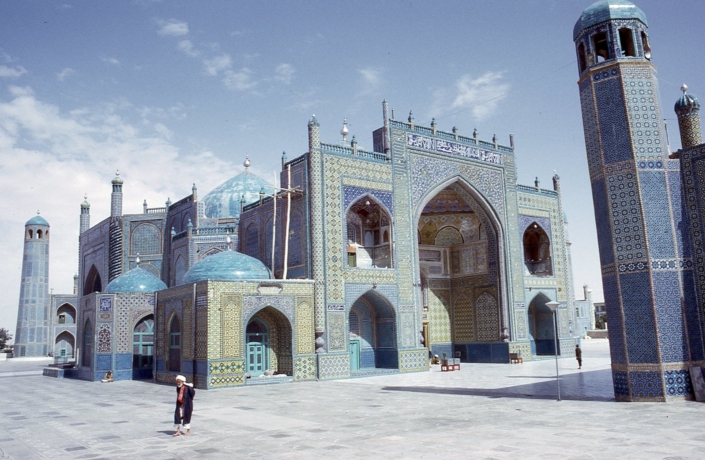
Shrine of Hazrat Ali (Blue Mosque) in Mazar-i-Sharif. Photo submitted by John and Barbara Ryan c. 1972-74.
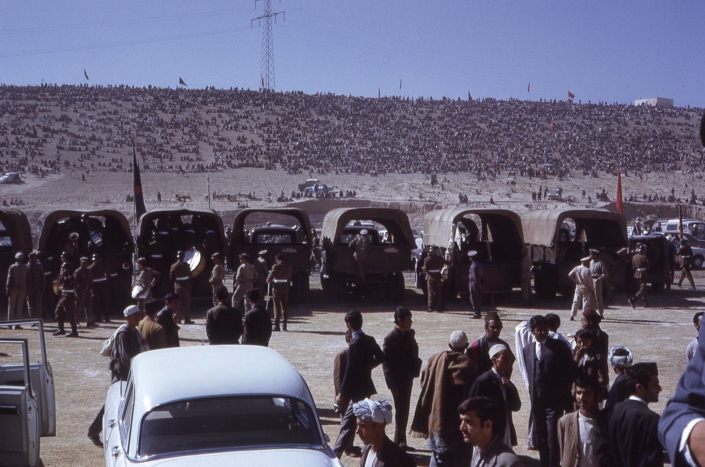
Crowd arriving for a budkashi game, a short distance outside Kabul, as part of the celebration for the national holiday. Photo submitted by John and Barbara Ryan c. 1972-74.
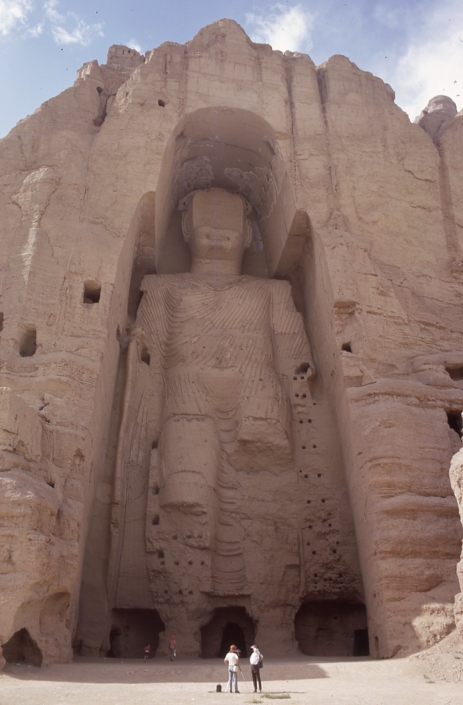
The 6th century Buddha of Bamiyan. Photo submitted by John and Barbara Ryan c. 1972-74.
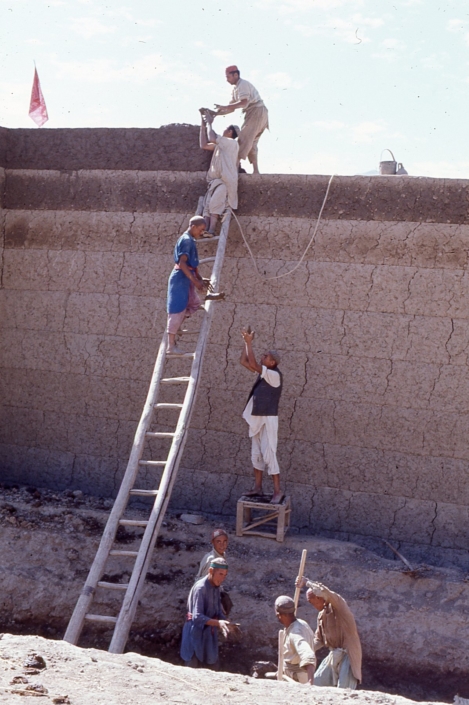
Constructing a mud and straw structure in rural Afghanistan. Photo submitted by John and Barbara Ryan c. 1972-74.
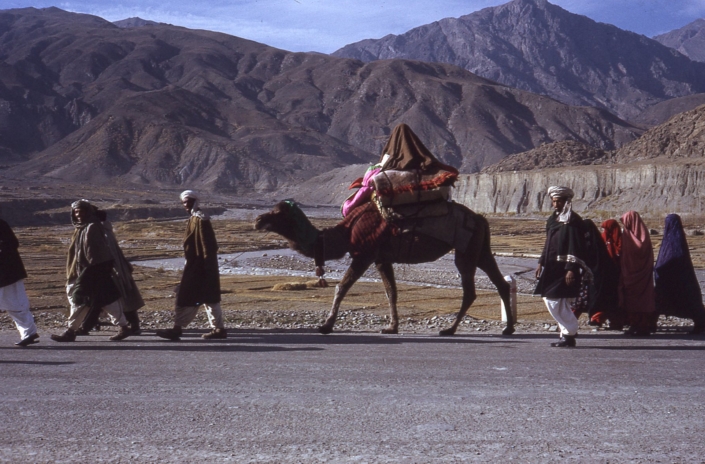
A wedding procession somewhere in rural Afghanistan. Photo submitted by John and Barbara Ryan c. 1972-74.
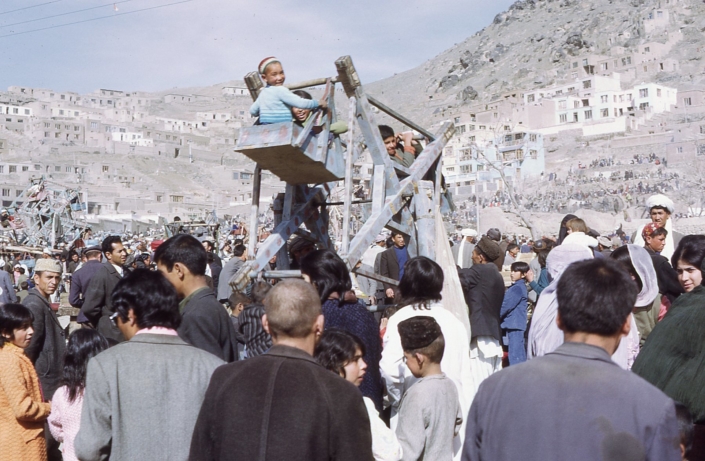
The children's ferris wheel at national day celebrations in Kabul and the adult ferris wheel in the background to the left. Note the joy on the faces of the children in the highest box. Photo submitted by John and Barbara Ryan c. 1972-74.
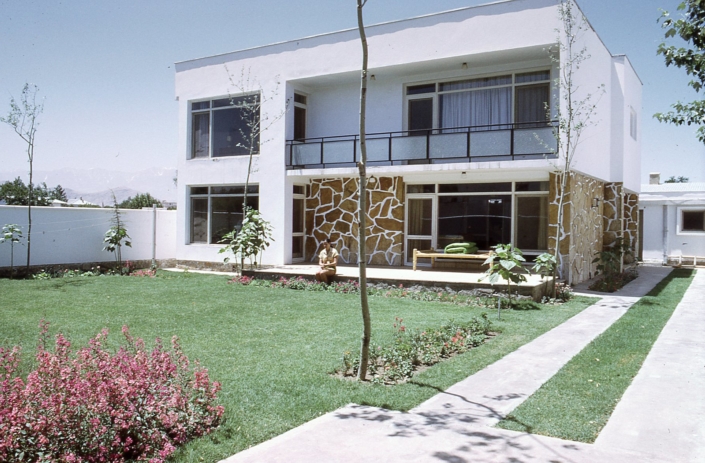
Our house in Wazir Akhbar Khan in mid-summer. Photo submitted by John and Barbara Ryan c. 1972-74.
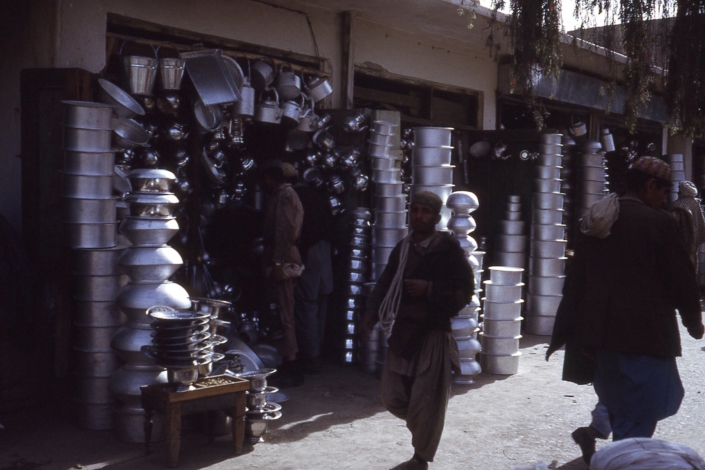
Tin pot bazaar in Kabul. Photo submitted by John and Barbara Ryan c. 1972-74.
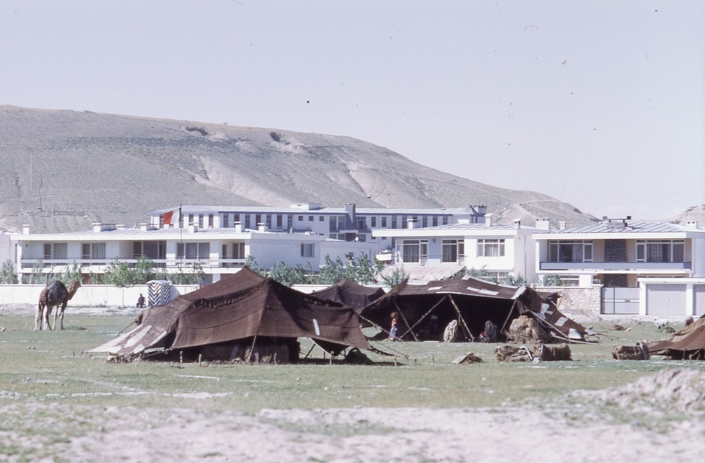
Kuchi encampment at the edge of Wazir Akbar Khan. Tapae Bemaru in the background. Photo submitted by John and Barbara Ryan c. 1972-74.
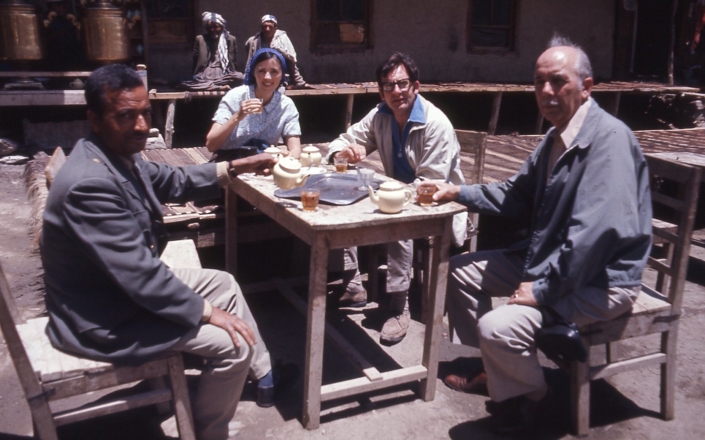
Canadian staff and driver Saleh Mohammed at chai-khana on road to Charikar. Photo submitted by John and Barbara Ryan c. 1972-74.

The Kabul-Jalalabad bus. The road through the Kabul River gorge was (and still is!) perilous. Photo submitted by John and Barbara Ryan c. 1972-74.
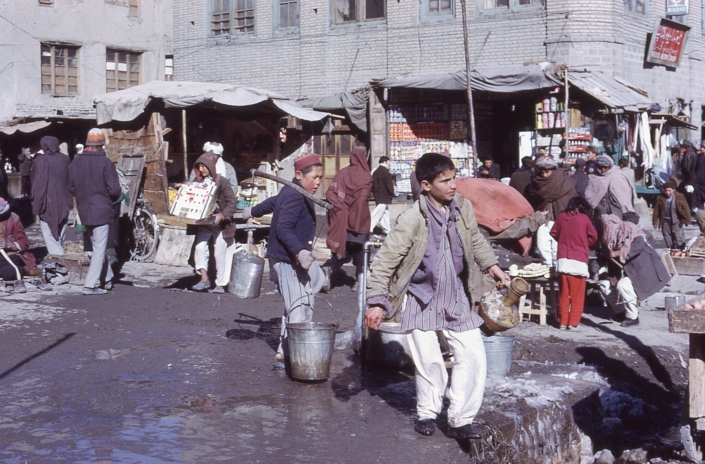
Boys collecting water from a street standpipe. Water from these ublic taps was available only for a few hours each day. Photo submitted by John and Barbara Ryan c. 1972-74.

Yurts, contructed for rental to foreign visitors at Bamiyan - designed based on traditional, portable structures used by nomadic peoples of Central Asia. Photo submitted by John and Barbara Ryan c. 1972-74.
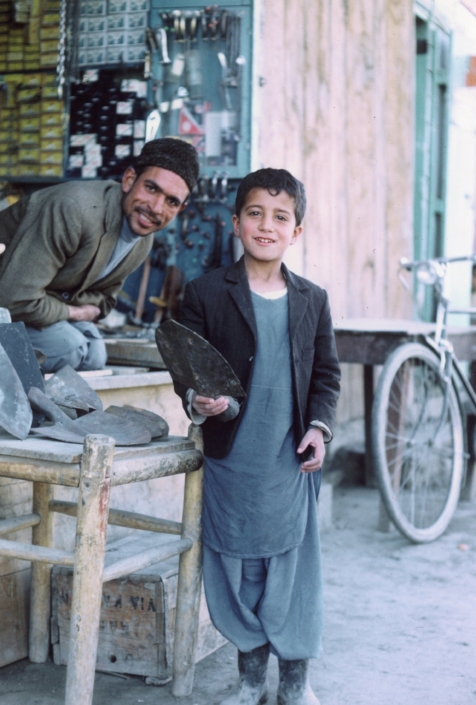
Father and son at their shop-house on Jadayi Maiwand. The shop was selling various items of hardware. The family lived in the area behind the ship. Despite the language difficulties, it was clear that the boy wanted to sell me a shovel. The father beamed with pleasure at the son’s sales pitch and bargaining skill. I was successful in communicating my request to take a photograph instead of buying a shovel. After the film was developed, I had an enlargement of this photo made and took it back to the boy. The father was ecstatic, shouting for his family and neighboring shop owners to come and see. I can’t help but wonder whatever happened to this family in the later war years. They seemed so happy, healthy and comfortable with their lives in this photo. Photo submitted by John Ryan c. 1972-74.

Kuchi mad with young son and dog, during a stop in Bamiyan. I believe the father was proud that we noticed or smiled and the child and he stopped to show us his precious son. I asked for a photo. He was reluctant at first, but soon recognized a business opportunity. The fair asking price was five afghanis, which would provide a day’s supply of fresh naan for the family. Photo submitted by John Ryan c. 1972-74.
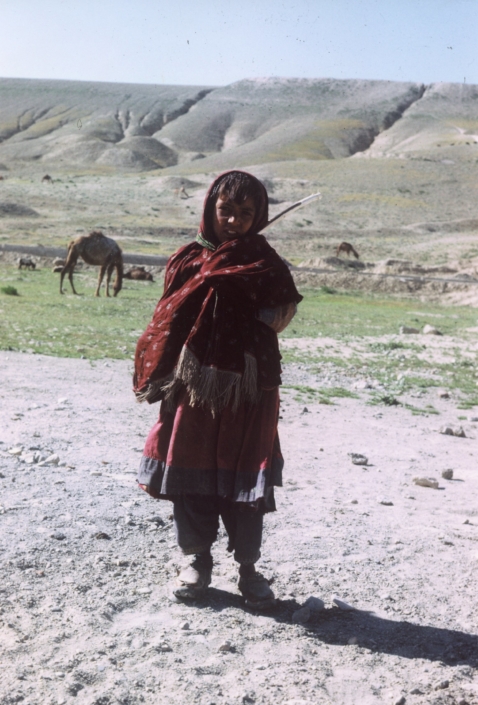
Kuchi girl guarding camels during a Kuchi caravan stopover in Kabul. This photo was taken with a telephoto lens. Tapae Bemaru in background. Photo submitted by John Ryan c. 1972-74.
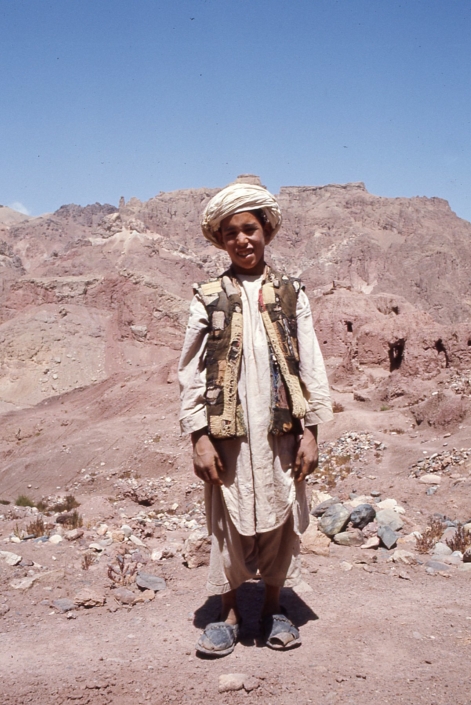
Young businessman at Bamiyan, offering guided tours of local attractions (at a fair price) including the path up the cliffs to the Red City and a “secret” pathway to the top of the Great Buddha. Photo submitted by John Ryan c. 1972-74.
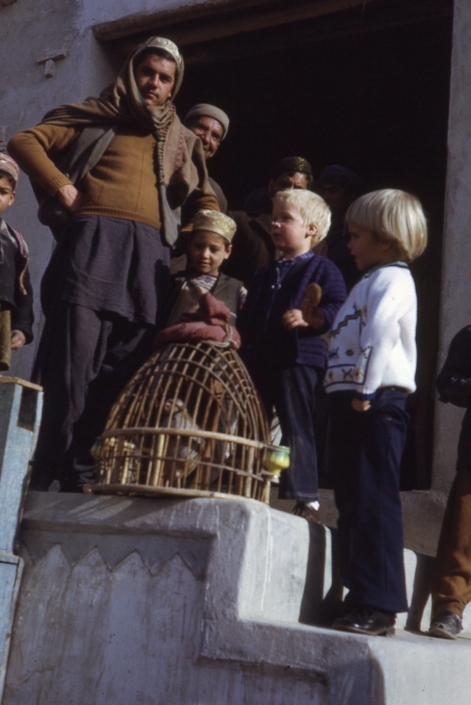
Two blond haired Canadian children, just as inquisitive as the Afghan children were. The Afghan boy with the bird in the cage caught their attention. These two young Canadian boys acquired and used Farsi vocabulary much faster than the adults did. Photo submitted by John Ryan c. 1972-74.
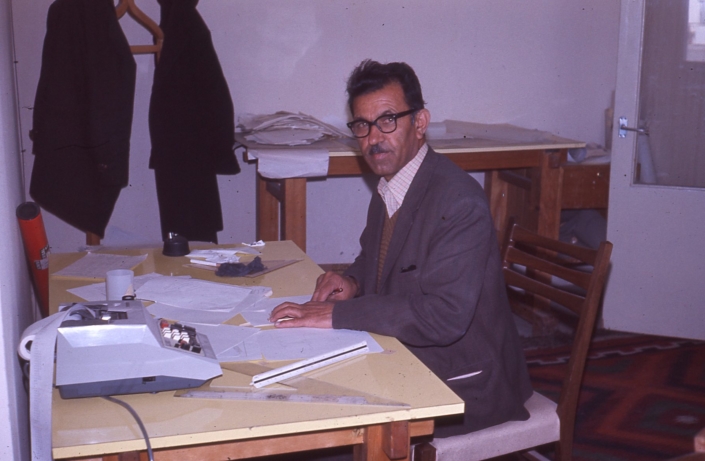
Mr. Sawar was a contact person with an intricate and invaluable knowledge of the large number of national ministries and local government departments. He had much knowledge of who was responsible for what and how to contact them. Photo submitted by John Ryan c. 1972-74.
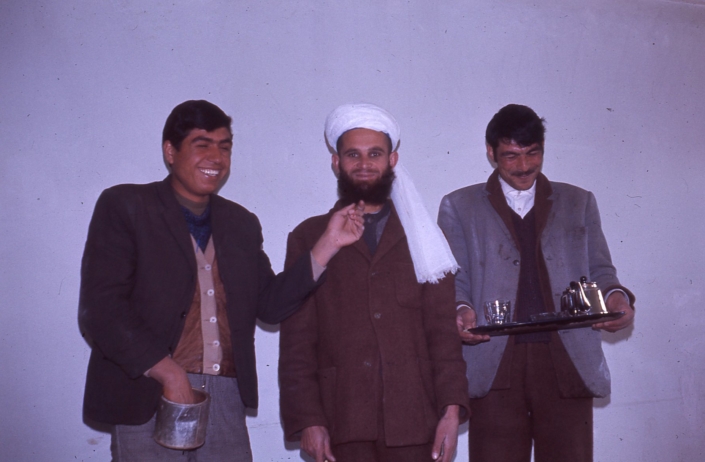
Tea is served. The man in the turban was in charge of serving tea every mid-morning and mid-afternoon. He was affectionately called “Mullah” because the Afghan staff thought he had the appearance of a holy man. Mullah had a crippled leg and a very pronounced limp, but that tea always arrived on time. The serving glasses were freshly scalded and the pots of tea were still boiling when they arrived. No one was going to contact any nasty bacteria on Mullah’s watch! The man on the right was Mullah’s assistant. The boy on the right was the office boy who did whatever chores were required. Photo submitted by John Ryan c. 1972-74.
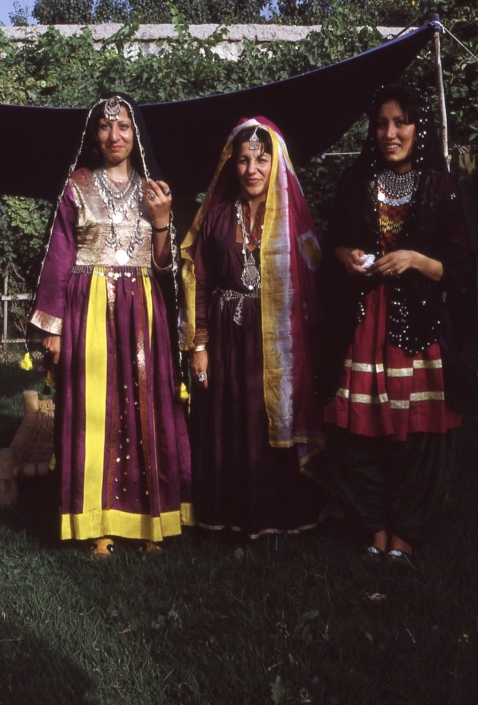
An Afghan dinner at our house. The Afghan women on the project came in traditional Afghan dresses. Fariaj, on the left, was the first female graduate in engineering from the University of Kabul. Madam in the middle had spent three years in Paris, where her husband was attached to the Afghan Embassy. Sajia on the right worked as a secretary with the WHO representative on our project. Photo submitted by John Ryan c. 1972-74.
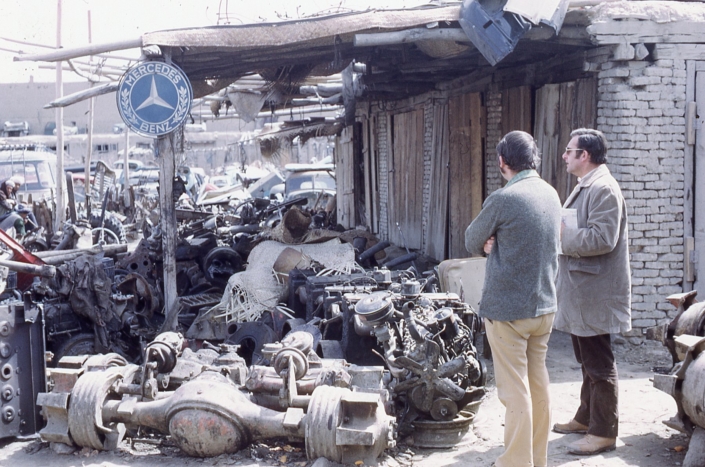
Two Canadians hoping to find a replacement part for a Land Rover. The owner of this establishment was able to provide the required part. Photo submitted by John Ryan c. 1972-74.

Purchasing wood by weight measured in kharwars. The wood sellers have a great number of dishonest tricks, whereby they can deceive a customer. The control weight, the lever arms of the scale, the positioning of the wood to be measured and in particular the large hook on the right side of the scale can be very quickly and very cleverly manipulated if the customer is distracted for a moment or two, and the same wood can get weighed twice. It would require a couple of pages to outline all the pit-falls of buying wood, a scarce and valuable commodity. Photo submitted by John Ryan c. 1972-74.
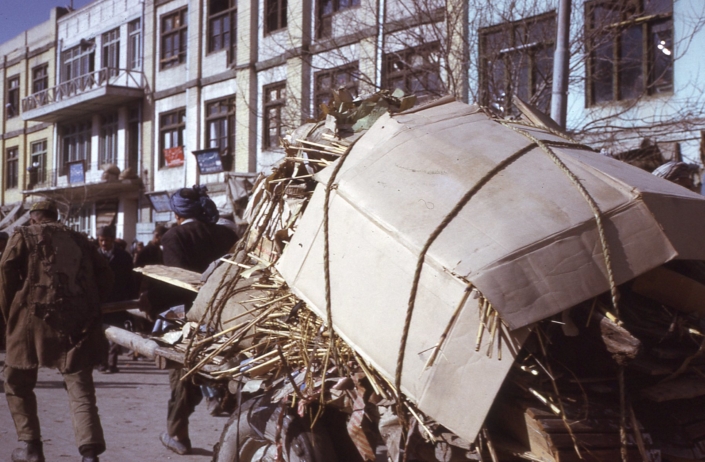
A “Karachi-cart” being hauled by two men. These man-powered carts were used to transport anything and everything around Kabul. Everyone on the cart in this photo will be recycled in some way. Photo submitted by John Ryan c. 1972-74.

We had a well in our compound and Baba the gardener kept the grass watered. A Kuchi man passing by noticed the ten cm high growth of fresh, healthy grass. He offered to cut our grass for free if he could keep the grass for his animals. The deal was concluded and early the next morning five women from his group arrived with small sickles to harvest the grass. Photo submitted by John Ryan c. 1972-74.
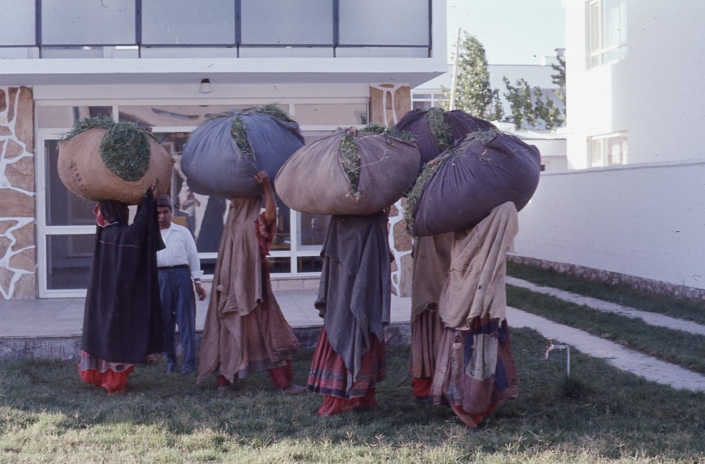
After the Kuchi women harvested the grass, we offered them tea, which they happily accepted, after an initial expression of surprise that a foreign woman had invited them to have tea with her on her front porch. They were obviously both amused and appreciative. One of the women had a nasty, festering wound on her hand and since some degree of trust had been established, she agreed to let us clean it and apply a dressing. Sterile water, a bottle of peroxide, a tube of Ozonol and a roll of gauze were the only items we had on hand, but in that day those simple materials were the only ingredients required to produce magic in a cross-cultural exchange. Photo submitted by John Ryan c. 1972-74.
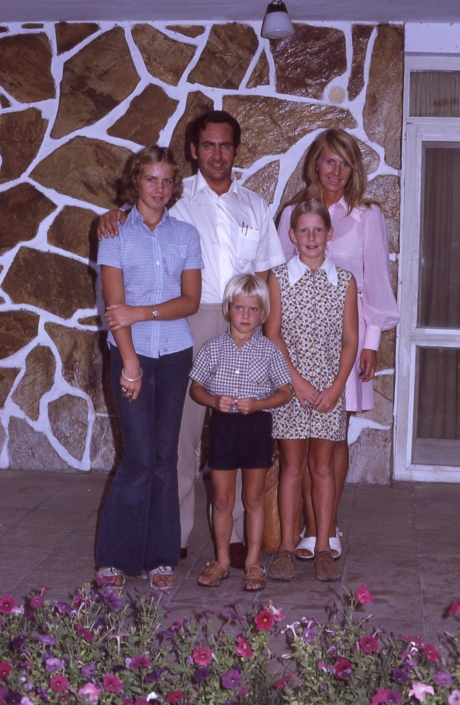
One of our Canadian families in Kabul from 1972 to 1974. These children would have learned invaluable lessons about life beyond the family unity, which could not be taught in any conventional classroom. Photo submitted by John Ryan c. 1972-74.
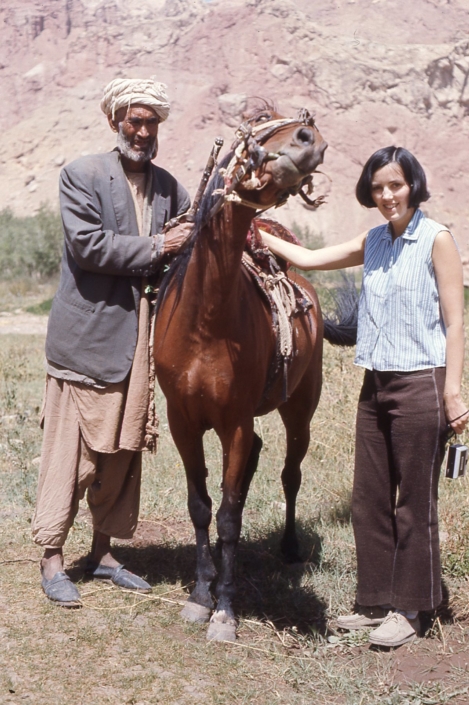
Horse for rent – The trail up the cliff-face to the site of the Red City in Bamiyan was steep and arduous by foot. We were assured that this horse was exceptionally sure footed and had traversed the trail many times, but as you might expect the offer was declined by this Canadian, notwithstanding the very fair rental fee being offered. Photo submitted by John Ryan c. 1972-74.
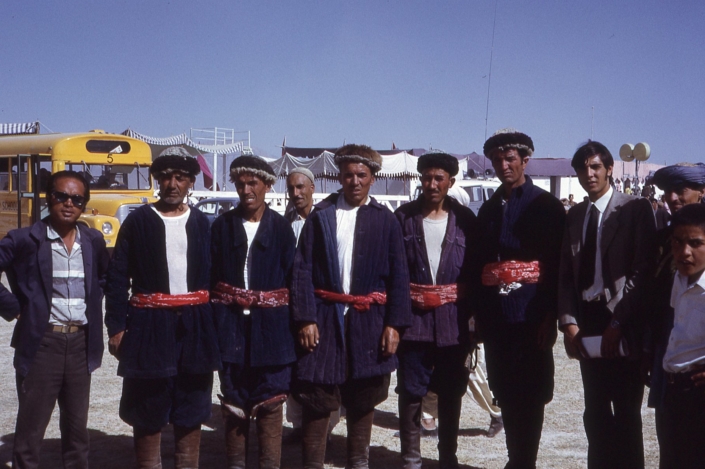
One of the buzkashi team of riders – Buzkashi was considered to be the national sport, and the best riders were treated as national heroes. Photo submitted by John Ryan c. 1972-74.

A buzkashi rider who had successfully evaded opposing riders – his horse about to explode into a full gallop toward the goal. In the heat of the contest, horse and rider seem to become a single entity. Photo submitted by John Ryan c. 1972-74.
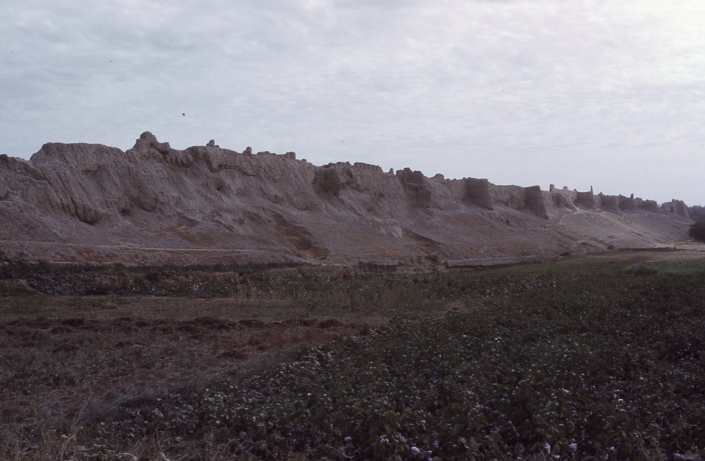
Ruins of the ancient city of Balkh. Being situated on ancient caravan routes from China and India, it was once a great centre of trade and commerce. The memories of several millennia of events lie buried there. Photo submitted by John Ryan c. 1972-74.
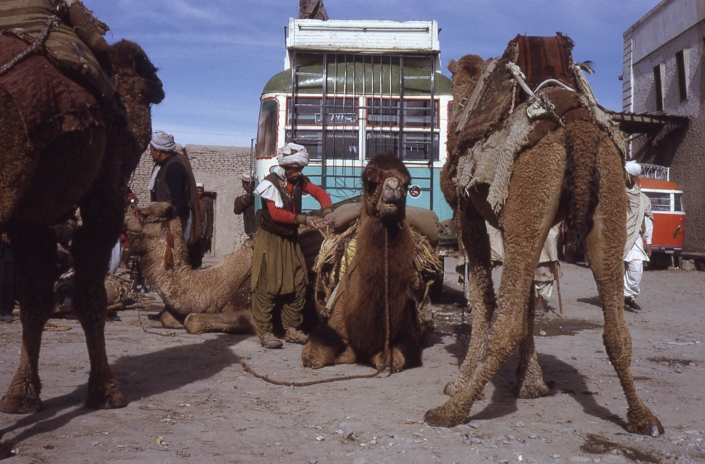
A stopover in Kandahar for camel caravans and commercial busses. Photo submitted by John Ryan c. 1972-74.
